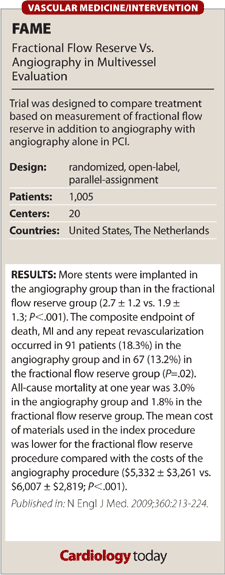FAME: Fractional flow measurement associated with lower AE rate when guiding PCI procedures
Routine measurement of fractional flow reserve in patients with multivessel disease undergoing percutaneous coronary intervention was associated with a lower rate of death, MI and repeat revascularization, study results suggested.
Researchers with the FAME study enrolled 1,005 patients with multivessel CAD for whom PCI was indicated and followed them for one year. Among them, 496 were randomly assigned to angiography-guided PCI and 509 were assigned to PCI guided by routine monitoring of fractional flow reserve in addition to angiography. The primary endpoint was the rate of major adverse cardiac events. More stents were implanted in the angiography group than in the fractional flow reserve group (2.7 ± 1.2 vs. 1.9 ± 1.3; P<.001). A total of 2,415 stents were implanted in the patients. The composite endpoint of death, MI and any repeat revascularization occurred in 91 patients (18.3%) in the angiography group and in 67 (13.2%) in the fractional flow reserve group (P=.02). The researchers also reported that the mean cost of materials used in the index procedure was lower for the fractional flow reserve procedure compared with the costs of the angiography procedure ($5,332 vs. $6,007; P<.001).
N Engl J Med. 2009;360:213-224.

